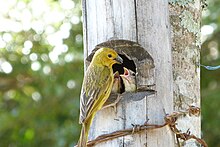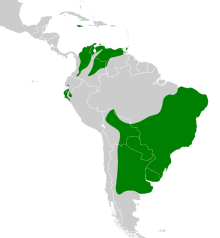Saffron finch
| Saffron finch | |
|---|---|

| |
| Male, Brazil | |

| |
| Female | |
| Scientific classification | |
| Domain: | Eukaryota |
| Kingdom: | Animalia |
| Phylum: | Chordata |
| Class: | Aves |
| Order: | Passeriformes |
| Family: | Thraupidae |
| Genus: | Sicalis |
| Species: | S. flaveola
|
| Binomial name | |
| Sicalis flaveola (Linnaeus, 1766)
| |

| |
| Synonyms | |
|
Fringilla flaveola Linnaeus, 1766 | |

In the Pantanal, Brazil
The saffron finch (Sicalis flaveola) is a
Emberizidae but it is close to the seedeaters
.
Taxonomy
The saffron finch was
type locality is Suriname.[4] The saffron finch is now placed in the genus Sicalis that was introduced in 1828 by the German zoologist Friedrich Boie.[5][6]
Five subspecies are recognised:[6]
- S. f. flaveola (Linnaeus, 1766) – Trinidad, Colombia, Venezuela and the Guianas
- S. f. valida Bangs & Penard, TE, 1921 – Ecuador and northwest Peru
- S. f. brasiliensis (Gmelin, JF, 1789) – east Brazil
- S. f. pelzelni Sclater, PL, 1872 – east Bolivia, Paraguay, southeast Brazil, north Argentina and Uruguay
- S. f. koenigi Hoy, G, 1978 – northwest Argentina
Description
The male is bright yellow with an orange crown which distinguishes it from most other yellow finches (the exception being the orange-fronted yellow finch). The females are more difficult to identify and are usually just a slightly duller version of the male, but in the southern subspecies S. f. pelzelni they are olive-brown with heavy dark streaks.
Breeding
Typically
nesting season, and territorial, which has led to the species being used for blood sporting with two males put in a cage in order to fight.[7][8]
References
- . Retrieved 12 November 2021.
- ^ Linnaeus, Carl (1766). Systema naturae : per regna tria natura, secundum classes, ordines, genera, species, cum characteribus, differentiis, synonymis, locis (in Latin). Vol. 1, Part 1 (12th ed.). Holmiae (Stockholm): Laurentii Salvii. p. 321.
- ISBN 978-1-4081-2501-4.
- ^ Paynter, Raymond A. Jr, ed. (1970). Check-List of Birds of the World. Vol. 13. Cambridge, Massachusetts: Museum of Comparative Zoology. p. 126.
- ^ Boie, Friedrich (1828). "Bemerkungen über mehrere neue Vogelgattungen". Isis von Oken (in German). 21. Cols 312–328 [324].
- ^ Rasmussen, Pamela, eds. (July 2020). "Tanagers and allies". IOC World Bird List Version 10.2. International Ornithologists' Union. Retrieved 16 October 2020.
- ISBN 978-85-61368-00-5, page 134
- ^ Peters, Sharon (9 March 2010). "Authorities crack down on finch-fighting rings". USA Today. Retrieved 26 April 2017.
External links
- Xeno-canto: audio recordings of the saffron finch
- Saffron Finch videos, photos & sounds on the Internet Bird Collection
- Stamps[usurped] (for Argentina, Brazil, Suriname)
- Saffron Finch photo gallery VIREO
- Saffron Finch Species Profile

